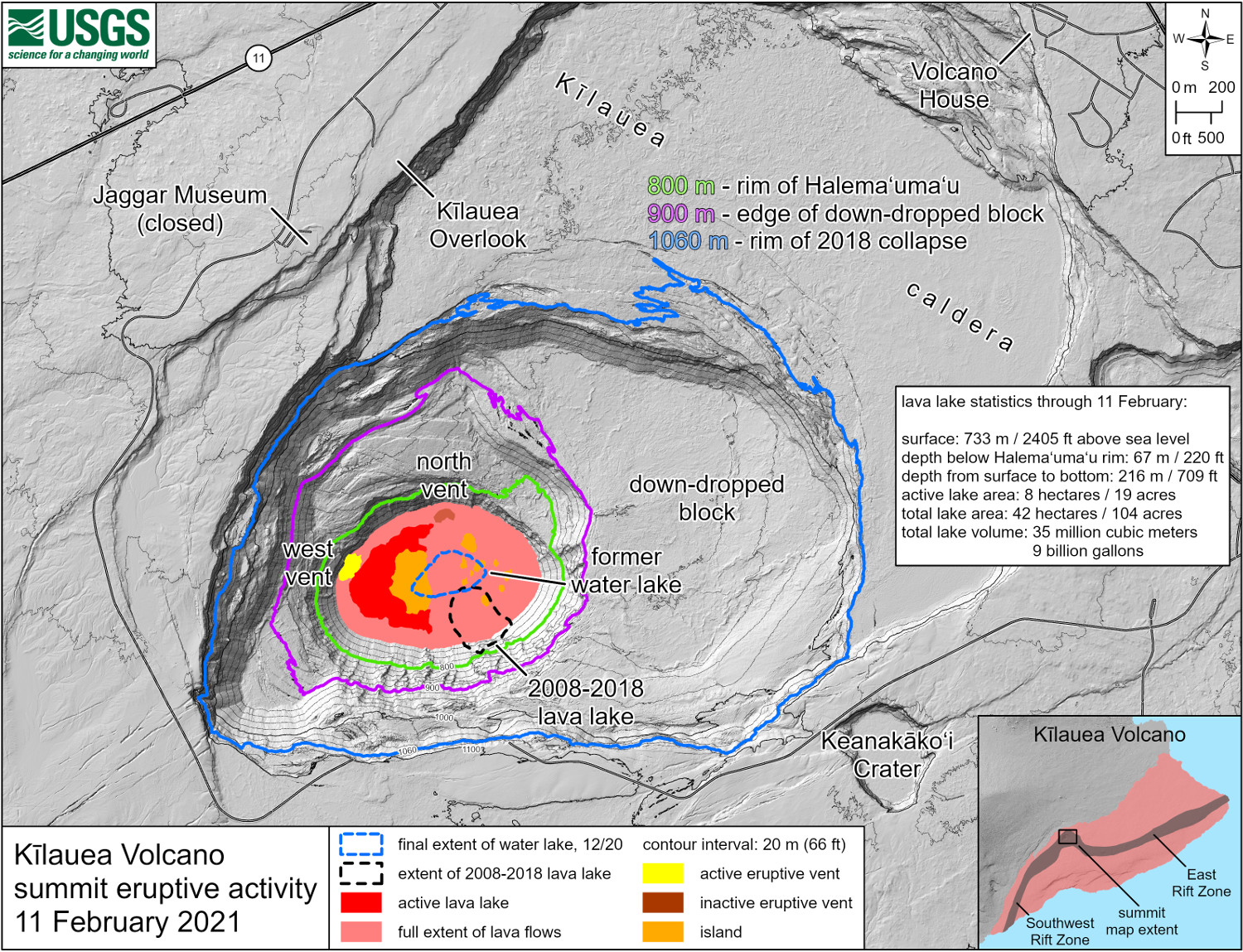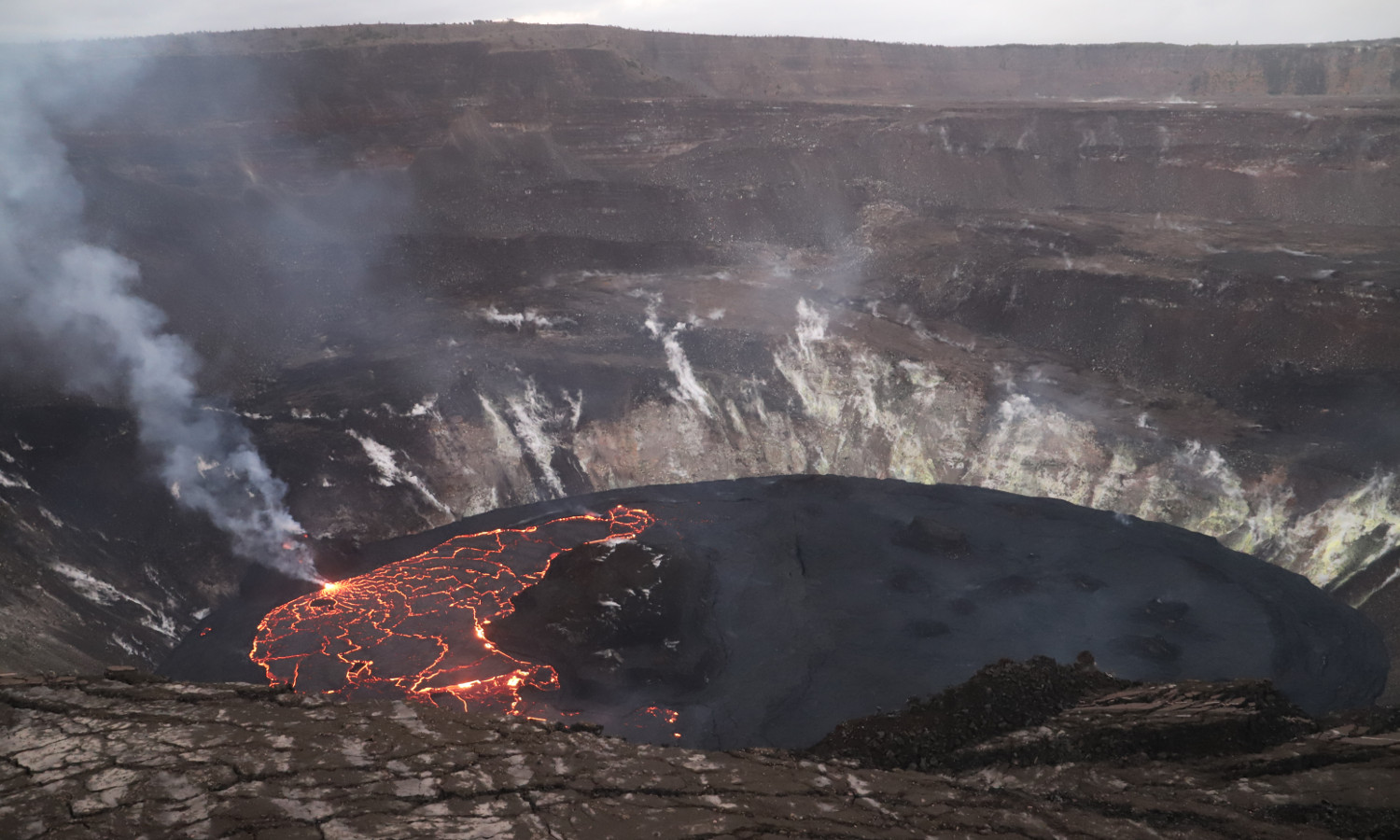
USGS HVO: This map of Halema‘uma‘u at the summit of Kīlauea shows 20 m (66 ft) contour lines (dark gray) that mark locations of equal elevation above sea level (asl). The map shows that the lava lake has filled 216 m (709 ft) of the crater, to an elevation of 733 m (2405 ft) asl since the eruption began at approximately 9:30 p.m. HST on December 20, 2020. Contour lines highlighted in green, purple, and blue mark the rim of Halema‘uma‘u, the edge of the eastern down-dropped block, and the rim of the 2018 collapse, respectively. Lava is expected to be within view of the Kīlauea Overlook visitor area shortly before it rises to the level of the green contour line at 800 m (2625 ft) asl. USGS map.
(BIVN) – The eruption of Kīlauea volcano continues, with the volcanic alert level currently at WATCH / ORANGE. All activity remains confined to the summit caldera.
As of the morning of February 12, the lava in the western, active portion of the lake in Halema‘uma‘u was about 708 feet deep, with the eastern portion of the lava lake solidified at the surface.
Sulfur dioxide emission rates remain elevated, and were last measured at about 1,200 t/d, which is lower than the emission rates from the pre-2018 lava lake (around 5,000 t/d).
The summit tiltmeters show inflationary tilt has mostly leveled off, but has not switched to deflation as of this morning’s data.
UPDATE – (10:30 a.m.) – From the USGS Hawaiian Volcano Observatory:
Activity Summary: Kīlauea Volcano is erupting. Lava activity is confined to Halemaʻumaʻu with lava erupting from a vent on the northwest side of the crater. As of the morning of February 13, the lava in the western, active portion of the lake in Halema‘uma‘u was about 216.5 m (710 ft) deep, with the eastern portion of the lava lake solidified at the surface. SO2 emission rates remain elevated.
Summit Observations: The most recent sulfur dioxide emission rate measurements from February 12 are about 1,100 t/d—lower than the emission rates from the pre-2018 lava lake (around 5,000 t/d). The summit tiltmeters show inflationary tilt continuing today. Seismicity remains elevated but stable, with elevated tremor and a few minor earthquakes.
East Rift Zone Observations: Geodetic monitors indicate that the upper portion of the East Rift Zone (between the summit and Puʻu ʻŌʻō) contracted while the summit deflated at the onset of this eruption. There is no seismic or deformation data to indicate that additional magma is currently moving into either of Kīlauea’s rift zones. SO2 and H2S emissions from Puʻu ʻŌʻō were below instrumental detection levels when measured on January 7.
Halemaʻumaʻu lava lake Observations: Lava from the west vent continues to supply the lava lake within Halema‘uma‘u crater.
The active western half of the lava lake was approximately 216.5 m (710 ft) deep today on February 13, 2021. The 0.5-meter rise since yesterday is consistent with ongoing inflation.
Yesterday, February 12, effusion from the west vent was steadily feeding a bubble-like inlet to the lava lake. Other activity in the western portion of the lava lake consisted of occasional crustal overturning at plate boundaries, and rare overflows onto the sloped margins of the lake. The western end of the lava lake was perched by 3 m (10 ft) above the distal margin of recent overflows. A series of surficial cracks separates the active western portion from the stagnant eastern portion of the lava lake. The position of the main island has not changed. As measured yesterday, the south end of the island was 9 m (30 ft) above the lava lake surface, with the highest point at 21 m (69 ft) above the surface. All other islands remain stationary, frozen in the stagnant portion of the lava lake.
Near-real time webcam views of the lava lake can be found here.
Hazard Analysis: High levels of volcanic gas, rockfalls, explosions, and volcanic glass particles are the primary hazards of concern regarding this new activity at Kīlauea’s summit. Large amounts of volcanic gas—primarily water vapor (H2O), carbon dioxide (CO2), and sulfur dioxide (SO2)—are continuously released during eruptions of Kīlauea Volcano. As SO2 is released from the summit during this new eruption, it will react in the atmosphere with oxygen, sunlight, moisture, and other gases and particles, and within hours to days, convert to fine particles. The particles scatter sunlight and cause the visible haze that has been observed downwind of Kīlauea, known as vog (volcanic smog), during previous summit eruptions. Vog creates the potential for airborne health hazards to residents and visitors, damages agricultural crops and other plants, and affects livestock operations. Rockfalls and minor explosions, such as the ones that occurred during the 2008–2018 lava lake eruption at Kīlauea summit, may occur suddenly and without warning. This underscores the extremely hazardous nature of Kīlauea caldera rim surrounding Halemaʻumaʻu crater, an area that has been closed to the public since late 2007. Pele’s hair and other lightweight volcanic glass fragments from the lava fountains within Halemaʻumaʻu will fall downwind of the fissure vents and lava lake, dusting the ground within a few hundred meters (yards) of the vent. High winds may waft lighter particles to greater distances. Residents are urged to minimize exposure to these volcanic particles, which can cause skin and eye irritation similar to volcanic ash.
Vog information can be found at vog.ivhhn.org.
Please see this Hawaii Volcanoes National Park Press Release “How to Safely View the New Eruption in Hawaiʻi Volcanoes National Park”.
The Hawaiian Volcano Observatory (HVO) continues to closely monitor Kīlauea’s seismicity, deformation, and gas emissions, and maintains visual surveillance of the summit and the East Rift Zone. HVO will continue to issue daily updates and additional messages as needed.


by Big Island Video News8:11 am
on at
STORY SUMMARY
HAWAIʻI VOLCANOES NATIONAL PARK - The eruption of Kīlauea volcano continues at the summit within Halemaʻumaʻu.